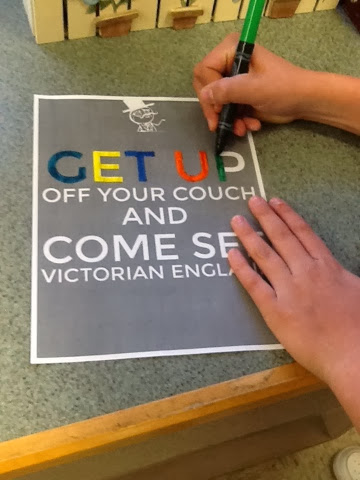So, we are building a museum. Literally. My classroom is slowly beginning to transform from just your average 7th grade classroom to full scale Victorian England museum. Although I'm only partially through this process, and the end result is yet to come, I couldn't be more excited about how it's going.
One of my goals in designing this project is to be as hands off as possible. I want them to own every piece of this museum from the beginning of our research to our opening day. I've provided some structure and guidance, but I'm really interested in seeing how they interact with one another, how they problem solve amongst themselves, and what they are able to create without the limitation of a menu of choices or a rubric.
At the start of the research process, students were asked to log onto their edline page, and find the folder with their topic on it. Inside the folder, I placed 2 very simplistic resources which give the students just a taste of their topic, but left many questions unanswered. After reviewing a Prezi detailing how to create well written research questions, students were asked to write 3 big picture questions (I called them "forest questions"), and for each of their big questions, they were asked to develop 3 small detail questions (I called them "tree" questions). They based their subsequent research off of those questions. I wanted them to take the direction in their research that they were interested in taking, rather than giving them specific questions to answer.
I loved watching them navigate through the research process. I gave groups the freedom to divide the research task however they wanted to, and it was fascinating to see the different ways that groups chose to do this. Some individuals had difficulty with group members not being on task, or feeling like they were doing all the work, or not being given any work to do. When they ran to tell me, rather than step in and make decisions or point fingers, I asked guiding questions to move them towards problem solving as a team. I asked questions like, "What is the goal you are trying to accomplish today as a group? What is stopping you from moving forward towards that goal? How can you work together to solve the problem?"
Each day in this process begins with a group meeting, where the "exhibit directors" read the memo from the "museum curator" (me.) The memo requires them to submit a goal for the day to their curator, and briefly explain how each group member will be contributing to this goal. Bringing this element of pretend and play into the activity has proven to be incredibly motivating. I hear things like, "Guys, our grand opening is in two weeks, we really need to get moving!"
I've also asked each group to create an advertisement for our museum. Some groups are recording 15 second commercials and podcasts, others are creating flyers and announcements to be read over the intercom. I've overheard groups saying things like, "We really need to make something that catches their eye!" or, "What parts of the building do sixth graders spend time in? Let's hang some fliers there," or, "Let's tell them a little bit about our topic, but not everything. Then they'll want to come see what it's all about!"
What do I love about this endeavor so far? I love that they are able to implement the element of pretend and play while still creating for an authentic audience. I love feeling confident that they will be able to more effectively connect the historical context of A Christmas Carol with the story's message, and thus connect the story's message more effectively to their own lives. These are all, for me, successes. But what I love most about this project is that they are almost completely in control, and they are coming up with ideas that I couldn't have thought of even on my best and brightest post workshop reenergized idea filled teacher day. They are truly owning the learning.




This is incredible Jenna, great job!
ReplyDeleteDad